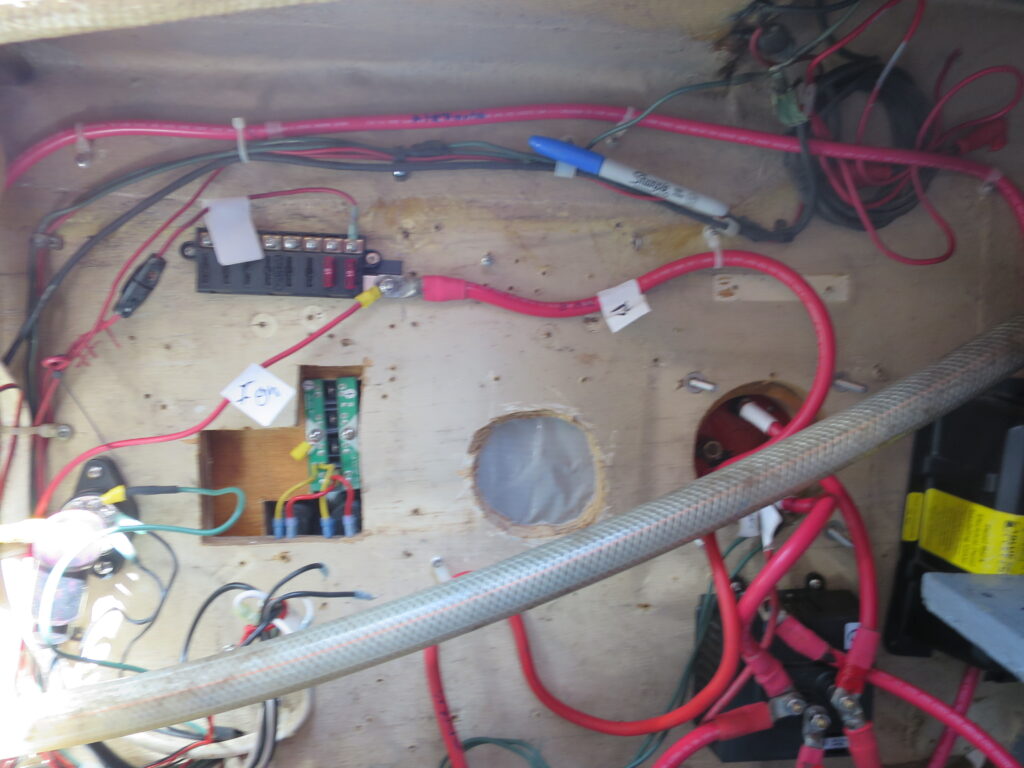Main Electrical Area




Electrical upgrades on a sailboat are crucial for safety, efficiency, and modern functionality. Here’s a step-by-step guide to help you navigate through the process:
- Assessment and Planning:
- Evaluate your current electrical system, identifying weaknesses or outdated components.
- Outline your upgrade goals, such as adding more power outlets, improving lighting, or integrating renewable energy sources.
- Create a Wiring Diagram:
- Draft a comprehensive wiring diagram that includes all existing and planned electrical components.
- Ensure compliance with marine electrical standards and regulations.
- Battery System Upgrade:
- Assess and replace outdated batteries with newer, more efficient ones.
- Consider upgrading to deep-cycle batteries or lithium-ion batteries for improved performance and longer life.
- Charging System:
- Upgrade the battery charging system, incorporating a modern marine battery charger or a smart charging system.
- Install solar panels or wind generators for renewable energy sources.
- Distribution Panel:
- Upgrade the distribution panel to accommodate additional circuits.
- Use a high-quality, marine-grade distribution panel with circuit breakers for each circuit.
- Wiring Replacement:
- Inspect and replace outdated or corroded wiring throughout the boat.
- Use marine-grade, tinned copper wire for durability and corrosion resistance.
- LED Lighting:
- Replace incandescent bulbs with energy-efficient LED lighting.
- LED lights consume less power, produce less heat, and have a longer lifespan.
- Safety Equipment:
- Install a galvanic isolator to protect against electrolytic corrosion.
- Upgrade or install a ground fault circuit interrupter (GFCI) in areas prone to water exposure.
- Navigation and Communication Electronics:
- Upgrade or install modern navigation instruments, GPS, and communication equipment.
- Consider a multifunction display (MFD) for consolidated information.
- Entertainment System:
- Upgrade the boat’s entertainment system, incorporating modern audiovisual equipment.
- Consider wireless connectivity options for seamless integration with personal devices.
- Monitoring System:
- Install a monitoring system to keep track of battery levels, water levels, and other critical parameters.
- Consider a smart monitoring system that can be accessed remotely.
- Documentation and Labels:
- Document the new electrical layout and wiring diagram.
- Label all circuits, switches, and components for easy identification and troubleshooting.
- Testing and Commissioning:
- Conduct thorough testing of each component to ensure proper functionality.
- Commission the upgraded system gradually, checking for any anomalies or issues.
- Training:
- Familiarize yourself and the crew with the upgraded electrical system.
- Provide training on basic troubleshooting and emergency procedures.
By following this step-by-step guide, you can systematically enhance the electrical system on your sailboat, ensuring a safer, more efficient, and technologically advanced maritime experience.
In-Depth Insight into Marine Electrical Maintenance: A Review of the Canadian Power and Sail Squadrons Course
The Marine Electrical Maintenance course offered by the Canadian Power and Sail Squadrons (CPS) stands out as a comprehensive and invaluable resource for sailors seeking a deep understanding of electrical systems on boats. As an avid sailor with a penchant for continuous learning, I recently completed this course, and I am compelled to share my positive experience.
The course begins with a solid foundation, covering the basics of marine electrical systems, safety protocols, and an overview of common components. The instructional material is presented in a clear and accessible manner, making it suitable for both beginners and seasoned sailors looking to refresh their knowledge.
What sets this course apart is its hands-on approach. Participants are not confined to theoretical concepts but are actively engaged in practical exercises and simulations. From understanding wiring diagrams to troubleshooting electrical issues, the course ensures that sailors gain practical skills that can be immediately applied on their vessels.
The curriculum addresses a wide spectrum of topics, including battery systems, charging mechanisms, navigation instruments, and the integration of renewable energy sources. The instructors, themselves seasoned sailors and experts in marine electrical systems, provide valuable insights and real-world scenarios that enrich the learning experience.
The course material is regularly updated to reflect the latest advancements in marine technology, ensuring that participants are equipped with relevant and up-to-date knowledge. The inclusion of case studies and practical demonstrations further enhances the learning journey, allowing sailors to grasp complex concepts with ease.
The emphasis on safety is commendable. The course underscores the critical importance of electrical safety measures on a boat, providing participants with the knowledge and skills to create a secure onboard environment. The focus on preventing electrolytic corrosion and installing ground fault circuit interrupters (GFCIs) aligns with industry best practices.
In conclusion, the Marine Electrical Maintenance course by the Canadian Power and Sail Squadrons is a gold standard for anyone seeking to enhance their understanding of marine electrical systems. Whether you are a novice sailor or an experienced mariner, the course offers a structured and engaging platform to delve into the intricacies of marine electrical maintenance, fostering a safer and more proficient sailing experience. I highly recommend it to fellow sailors who are committed to mastering the essential skills of marine electrical maintenance.
